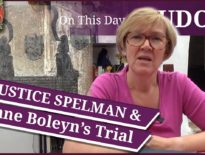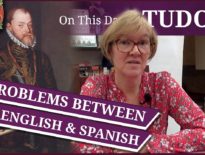25th January is the Feast of the Conversion of St Paul, an important day in Tudor times. It celebrated the conversion of Saul, a man known for his persecution of Christians, on the road to Damascus.
In today's talk, I explain the background of the feast day and shares a contemporary account of how St Paul's Day was celebrated in the reign of Queen Mary I.
St Paul's Day 1533 was the day of the official, but secret, marriage of King Henry VIII and Anne Boleyn at Whitehall Palace. I spoke about it in last year’s video:
I mention Wyatt's Rebellion in this video and you can see my video on that here:
Also on this day in history:
- 1540 – Birth of Edmund Campion, Jesuit and martyr St Edmund Campion, in London. He was hanged, drawn and quartered on 1st December 1581 for treasonable conspiracy. Campion was beatified in 1886 by Pope Leo XIII and canonized in 1970 by Pope Paul VI.
- 1559 – Elizabeth I's first Parliament was inaugurated.
- 1567 – Death of Sir William Hewett, Lord Mayor of London from 1st September 1559.
- 1586 – Robert Dudley accepted the title of Governor-General of the Netherlands.
Transcript:
Today is the Feast of the Conversion of St Paul, an important day in Tudor times. It was a feast day in celebration of the conversion of Saul, a man known for his persecution of Christian, on the road to Damascus. The story of Saul’s conversion is found in the New Testament in Acts 9. Let me share with you Reformer Willian Tyndale’s translation of the story:
“And Saul yet breathing out threatenings and slaughter against the disciples of the lord went unto the high priest and desired of him letters to Damascus to the synagogues, that if he found any of this way, whether they were men or women, he might bring them bound vunto Jerusalem. But as he went on his journey, it fortuned it he drew night to Damascus, and suddenly there shined round about him a light from heaven. And he fell to the earth and heard a voice saying to him: Saul Saul why persecutest thou me? And he said, what art thou lord? And the lord said, I am Jesus whom thou persecutest, it shall be hard for ye to kicke against the prick. And he both trembling and astonied said: Lord, what wilt thou have me to do? And the Lord said unto him: arise and go into the city and it shall be told thee what thou shalt do. The men which journeyed with him stood amazed for they heard a voice but saw no man. And Saul arose from the earth and opened his eyes, but saw no man. Then led they him by the hande and brought him into Damascus. And he was 3 days without sight and neither ate nor drank.
And there was a certain disciple at Damascus named Ananias and to him said the lord in a vision: Ananias. And then he said: beholde, I am here lord. And the lord said to him: arise and go into the street which is called straight, and seek in the house of Judas after one called Saul of Tarsus. For behold he prayeth and hath seen in a vision a man named Ananias coming in to him and putting his hands on him that he might receive his sight. Then Ananias answered: Lord, I have heard by many of this man, how much evil he hath done to thy saints at Jerusalem, and here he hath authority of the high priests to bind all that call on thy name. The lord said unto him: Go thy ways: for he is a chosen vessel unto me to bear my name before the gentiles and kings and the children of Israel. For I will show him how great things he must suffer for my names sake.
Ananias went his way and entered into the house and put his hands on him and said: brother Saul, the lord that appeared unto thee in the way as thou camest, hath sent me that thou mightest receive thy sight and be filled with the holy ghost. And immediately there fell from his eyes as it had been scales, and he received sight and arose and was baptised and received meat and was comforted.”
Saul stopped persecuting Christians, converted to Christianity and became Paul the Apostle and great evangelist.
In Queen Mary I's reign, the Feast of St Paul's was celebrated with torchlit processions and bonfires. Perhaps this light symbolised the light from Heaven which Saul saw. Here is an account of St Paul’s Day 1555 from merchant-tailor and diarist Henry Machyn:
“The xxv day of January, being saint Paul's day, was a general procession of saint Paul by every parish, both priests and clerks, in copes to the number of a hundred and sixty, singing Salve festa dies, with ninety crosses borne. The procession was through Cheap into Leadenhall. And before went the children of the Greyfriars and Paul’s school. There were eight bishops, and the bishop of London mitred, bearing the sacrament, with . . (bit missing)... of torches burning, and a canopy borne over; so about the church-yard, and in at the west door, with the lord mayor and the aldermen, and all the crafts in their best liveries. And with-in a while after the King came, and my lord cardinal, and the Prince of Piedmont, and diverse lords and knights; they heard mass, and after to the court to dinner, and at night bonfires and great ringing in every church.”



Leave a Reply